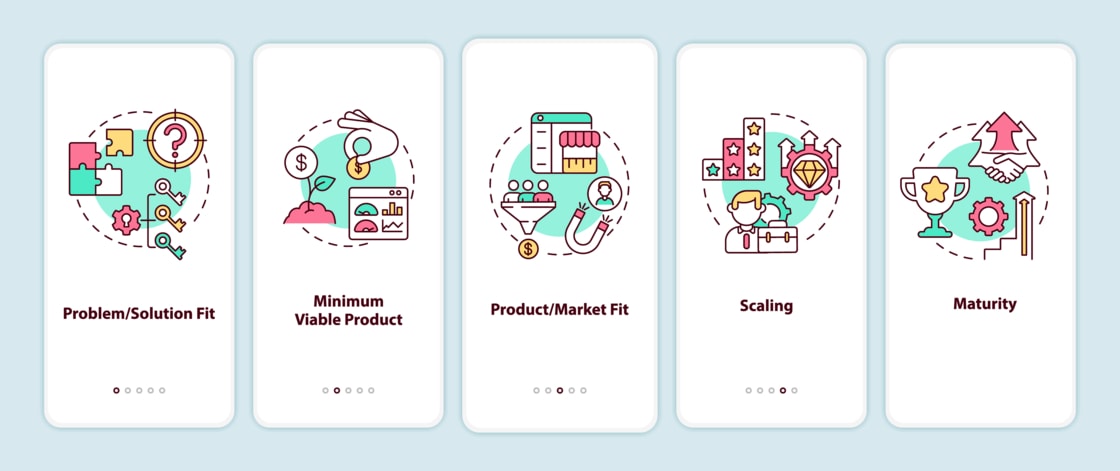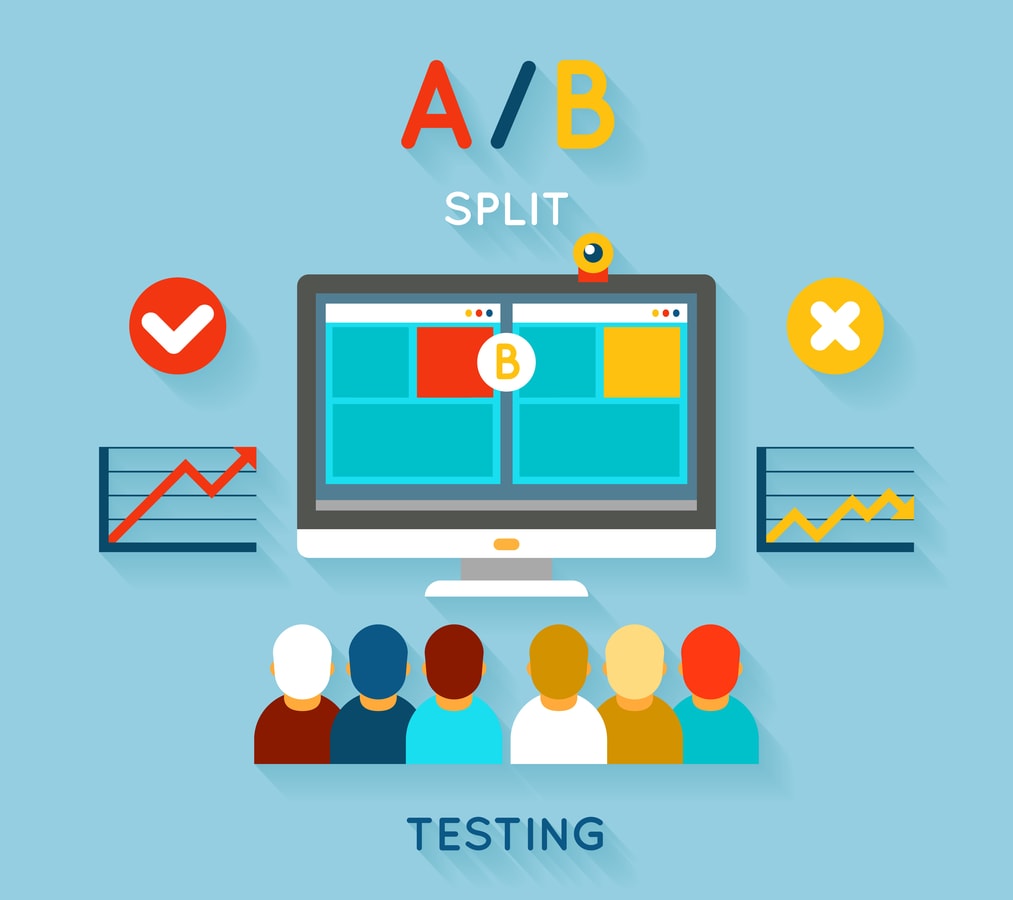Finding product/market fit (PMF) is key to startup success. But what exactly is PMF? And how do you achieve it? The Product-Market Fit Pyramid provides a framework for understanding and achieving PMF.
It’s important to note that there is no one-size-fits-all approach to achieving PMF. The path to PMF will vary from startup to startup and even from product to product within the same startup.
It’s also important to remember that PMF is not a destination. Once you’ve achieved it, you need to continue working to maintain and grow your product’s market fit. This lean product process from Eric Ries illustrates the never-ending cycle of building, measuring, and learning that is essential to startup success.
The Product Market Fit Pyramid has four levels: Awareness, Interest, Decision, and Advocacy. Each level represents a different stage in the customer journey.
Every level of the Product Market Fit Pyramid is important, but some levels are more important than others. For example, Awareness and Interest are necessary for getting customers to try your product. But if they’re not interested in what you’re offering, they’ll never get to the Evaluation stage.
When it comes to achieving PMF, the most important level is Decision. This is when customers make a purchase or sign up for your product.
To achieve PMF, you need to start at the bottom of the pyramid and work your way up. In this post, we’ll explore the different levels of the pyramid and what they mean for your business. We’ll also look at some tips for making your product irresistible to buyers. So, whether you’re just starting or looking to take your business to the next level, read on to learn more about the Product-Market Fit Pyramid!
What is Product Market Fit (PMF)?
Product market fit (PMF) is the degree to which a product meets the needs of its target market. In other words, it’s the fit between what you’re offering and what your target market wants. The lean product playbook from Eric Ries defines it as “the moment when a startup has successfully identified a market opportunity and built a product that captivates this audience.”
PMF is often used to measure a startup’s success in the startup world. That’s because startups that have found PMF are more likely to succeed in the long run.
It is a well-known fact that most startups fail. In fact, according to CB Insights, 90% of startups fail.
The main reason startups fail is because they don’t have PMF. They either build a product that no one wants, or they build a product that doesn’t meet the needs of their target market.
To be successful, startups need to find PMF. And the only way to do that is to keep iterating until they find a product/market fit that works. Since PMF is so important, it’s no surprise that startups spend a lot of time and energy trying to achieve it.
The Four Stages of the PMF Pyramid
The Product-Market Fit Pyramid is a framework that can help you understand and achieve PMF. It’s made up of four levels, each representing a different stage in the customer journey:
Awareness
Awareness is the first stage of the customer journey. This is when customers become aware of your product or service.
There are several ways to generate awareness for your product. For example, you can use marketing campaigns, PR, or word-of-mouth. When it comes to generating awareness, the most important thing is to reach your target market. And the best way to do that is to use channels that your target market is already using.
Since awareness is the first stage of the customer journey, it’s also the most important. If customers are not aware of your product, they can’t buy it.
So always keep in mind that the goal of awareness campaigns is to reach your target market and get them interested in your product.
Interest
Interest is the second stage of the customer journey. This is when customers become interested in your product or service. It’s important to note that interest is different from awareness. Customers are not just aware of your product in the interest stage—they’re also interested in it.
You need to use marketing techniques beyond just raising awareness to generate interest. For example, you can use content marketing, social media, or influencer marketing. These marketing techniques aim to get potential customers interested in your product.
And once you’ve generated interest, it’s important to keep it going. The best way to do that is to keep your target market engaged with relevant and interesting content.
Decision
The Decision stage is when customers purchase or sign up for your service.
You need to use marketing techniques beyond raising awareness and generating interest to get to this stage. For example, you can use lead generation campaigns, webinars, or free trials. The goal of these marketing techniques is to get potential customers to take action and make a purchase. The minimum viable product (MVP) is a product with just enough features to be usable by early adopters.
And once you’ve generated a sale, it’s important to keep the customer happy. The best way to do that is to provide an excellent customer experience. This includes everything from customer service to product support.
Advocacy
Advocacy is the final stage of the customer journey. This is when customers become brand advocates and promote your product or service to others.
There are several ways to generate advocacy for your product. For example, you can use referral programs, social media, or user-generated content. These marketing techniques aim to get customers to promote your product to others.
And once you’ve generated advocacy, it’s important to keep it going. The best way to do that is to keep your advocates happy. The best way to do that is to provide them with valuable content, exclusive deals, and other perks.
With every stage of the Product-Market Fit Pyramid, it’s important to keep two things in mind:
- The goal is to reach your target market.
- The best way to do that is to use channels your target market is already using.
By following these two rules, you’ll be well on your way to achieving product-market fit.
Do you need help to achieve product market fit?
How to Achieve the Product Market Fit?
Now that we’ve gone over the Product-Market Fit Pyramid, let’s talk about how you can achieve product-market fit.
Do your research
The first step is to do your research. This includes everything from market research to customer research. You need to understand your target market and what they’re looking for. Only then can you create a product that meets their needs.
Since market and customer research can be time-consuming, it’s important to start with a problem that you’re passionate about. That way, you’ll be more motivated to do the research.
During this research phase, it’s also important to validate your ideas. The best way to do that is to talk to potential customers and get their feedback. This will help you refine your product and ensure it’s something that people want.
Create a great product
The second step is to create a great product. This might seem obvious, but it’s the most important step. If you don’t have a great product, you’ll never achieve product-market fit.
To create a great product, you need to start by understanding your target market. Once you understand their needs, you can create a product that meets them.
It’s also important to keep your product simple. The more complex your product is, the harder it will be to use. And if your product is hard to use, people won’t want to use it.
You can also make your product more attractive by adding unique features that your competitors don’t have. This will make your product more appealing to potential customers.
Market your product
The third step is to market your product. This is where the Product-Market Fit Pyramid comes in. You need to use marketing techniques that are relevant to your target market.
For example, if you’re selling a B2B product, you’ll need to use lead generation campaigns. If you’re selling a B2C product, you’ll need to use social media.
The goal of marketing is to generate interest in your product. Once you’ve generated interest, you can use other marketing techniques to get people to make a purchase.
You can also generate interest by creating valuable content. This can be in blog posts, infographics, or even e-books. The goal is to provide potential customers with information that they’ll find useful.
Get feedback from your customers.
The fourth step is to get feedback from your customers. This is important for two reasons. First, it will help you improve your product. Second, it will help you generate word-of-mouth marketing.
The best way to get feedback from your customers is to talk to them. You can do this in person, by phone, or by email. You can also use surveys, polls, and forums.
Feedback is important, but you need to be careful how you use it. You should only make changes to your product if they’re necessary. Otherwise, you risk making your product worse.
Keep improving your product.
The fifth and final step is to keep improving your product. This is an ongoing process that never really ends. As your product evolves, so does the market. And as the market changes, so do your target market.
To keep up with the changes, you need to improve your product continuously. This includes adding new features, fixing bugs, and making design changes.
You also need to keep up with the latest marketing trends. This way, you can ensure that your marketing efforts are aligned with your product.
Product-market fit is the holy grail for startups. It’s what every startup is trying to achieve. And it’s not easy. It’s one of the hardest things to do in business.
But if you can achieve product-market fit, you’ll be well on your way to success.
Now is the time to implement the product market fit pyramid.
The Benefits of Achieving PMF
Now that we’ve gone over what product-market fit is let’s discuss the benefits of achieving it.
Helps in target customer identification
The first benefit is that it helps you identify your target market. If you don’t have a product-market fit, you’ll have difficulty finding your target market.
But once you achieve product-market fit, you’ll know exactly who your target market is. This will save you a lot of time and money in the long run.
Value proposition testing
The second benefit is that it allows you to test your value proposition. Your value proposition is the main reason why someone should buy your product.
If you don’t have a product-market fit, you won’t be able to test your value proposition effectively. But once you achieve product-market fit, you can use it as a way to test your value proposition.
Reduce the risk of startup failure.
Product-market fit is also a great way to reduce the risk of startup failure. Startups fail for many reasons, but one of the main reasons is that they can’t find their target market.
If you have a product-market fit, you’ll know exactly who your target market is. This will help you avoid many common mistakes that startups make.
Easier to raise capital.
Raising capital is one of the most difficult things for startups to do. But if you have a product-market fit, it will be a lot easier.
This is because investors want to see that you have a product that people want. They’re not going to invest in a startup that doesn’t have a product-market fit.
Product-market fit is the key to startup success. It’s what every startup should be striving for. If you can achieve it, you’ll be well on your way to becoming a successful business.
Helps you build a better product.
Another benefit of product-market fit is that it helps you build a better product. This is because you’re constantly getting feedback from your customers. Most importantly, it helps to identify underserved customer needs in the market, which can jelp your startup to succeed.
This feedback will help you improve your product and make it even more appealing to your target market. You can use this feedback to make design changes to your business model, add new features, and fix bugs.
Better understand your customer needs.
Most important of all, product-market fit helps you better understand your target customers. This is because you’re constantly in contact with them.
You’re constantly getting feedback from them, and you’re always trying to improve your product to meet their needs. This gives you a much better understanding of who they are and what they want.
Focus on the right things.
Last but not least, product-market fit helps you focus on the right things. When you don’t have a product-market fit, it’s easy to get distracted by all of the different things that you could be doing.
But once you have product-market fit, you’ll know exactly what you need to do to grow your business. You’ll be able to focus on the things that matter and ignore those that don’t. Due to this, the customer lifetime value will increase.
Final Words on the Product-Market Fit Pyramid
Whether you use the conventional PMF process or the Superhuman product-market fit process, know that PMF is the key to startup success. It’s what every startup should be striving for. If you can achieve it, you’ll be well on your way to becoming a successful business.
With product-market fit, you’ll be able to focus on the things that matter and ignore the things that don’t. You’ll also be able to build a better product and understand your customers better.
So what are you waiting for? Start working on achieving product-market fit today! And if you need help, feel free to contact us. We’re always happy to help out startups and businesses achieve their goals.
Growth Hackers provides proven marketing automation services helping businesses from all over the world grow. There is no fluff with Growth Hackers. We help entrepreneurs and business owners achieve product market fit, generate qualified leads, optimize their conversion rate, gather and analyze data analytics, acquire and retain users and increase sales. We go further than brand awareness and exposure. We make sure that the strategies we implement move the needle so your business grow, strive and succeed. If you too want your business to reach new heights, contact Growth Hackers today so we can discuss about your brand and create a custom growth plan for you. You’re just one click away to skyrocket your business.









1 Comment
Wonderful tips. Thank you!